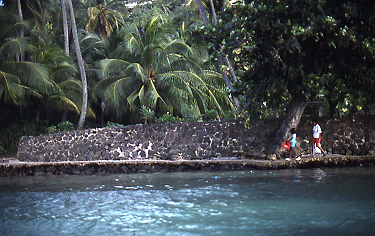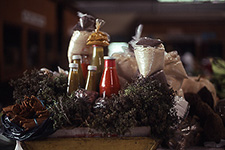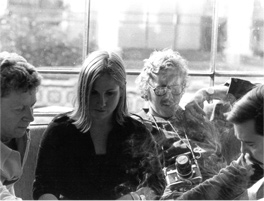Colonial Carribean

Bequia (pronounced Beck-way) is part of the Grenadines, a chain of over one hundred islands and reefs extending more than sixty miles between St. Vincent and Grenada. This is the least-developed edge of the Caribbean where small inns have not been replaced by high-rise resorts and golf courses; whirling fans outnumber air conditioners. The population supports itself from farming and fishing, not tourism, and the few airports accommodate only small aircraft. The entire area is a sailor’s haven as many of the islands are accessible only from the sea.

Kristen and I flew into Kingstown, St. Vincent, from Barbados. Rum punch sprinkled with freshly grated nutmeg in hand, we sat in an open window of the old-style Heron hotel where we were staying–our seat offering the perfect view of trucks laden with bananas waiting patiently in queue to unload their goods onto the massive cargo ships anchored in the harbor. The next day we rented a jeep and drove along winding roads, up steep hills and over rushing rivers into the lush interior rain forest aptly named Mesopotamia Valley. The nearby volcano had created acres of rich fertile soil that were jam-packed with pineapples, limes, and exotic tropical flowers shrouded in a perpetual mysterious mist. We couldn’t believe we were in the Caribbean; it certainly wasn’t like any place our parents had taken us to on family vacations. When the swollen gray clouds suddenly burst, we watched harvesters casually improvise banana leaves into umbrellas before resuming work.

The Saturday food market in Kingstown is one of the largest in the Caribbean and the vendors who couldn’t fit inside the covered building spilled into the surrounding streets, the women shielding themselves from the sun with parasols. Local farmers happily explained the uses of dasheen, christophene, callaloo, soursop, sugar apples, a variety of unearthly, hairy, mangled tubers, huge pumpkins slashed open to reveal their deep cadmium orange interiors and piles of breadfruit. In 1793 Captain Bligh introduced the breadfruit tree on St. Vincent. It is rumored that when Bligh came from Tahiti on the Bounty, he gave more water to the plants than to his crew, thus instigating the mutiny.
The ferry departs for the outer islands twice a day–an inexpensive and entertaining means of transport. When we arrived in Bequia, a crowd was waiting on the dock to greet friends, get mail, or collect the cases of soda, engine parts, furniture, and ten-kilo sacks of brown sugar they’d ordered. No addresses were on the items, only a name and an island. Enid Johnson, Canouan; Oliver Baptiste, Union. We stayed in the original wood and stone building of the Frangipani built in the early 1800’s, once the family home of the current Prime Minister. Our room, complete with mosquito net draped beds, overlooked the terrace bar facing the waterfront. This was one of the great meeting places in the Grenadines and we’d hear the sound of dice clicking on board games and ice clinking in glasses as we dressed for dinner. Yachters mingled with Rastafarians, expatriates with travelers, the young with the old. Everyone spoke with everyone. Kristen and I had never been anywhere like it.
“Main Street” was a path only wide enough for one person that meandered over sand, rock and through the water at high tide. We learned after the first night to only wear skirts or pants that could easily be hiked up and to never wear shoes. We passed small restaurants and shops that had wonderful names like Whaleboner, Gingerbread and Old Fig Tree. One couldn’t be in Bequia more than two hours and not hear about Mac’s lobster pizza.

Such enticing descriptions! Maybe I should move to the Caribbean. I’ve not been to the Grenadines, but did visit Barbados and St. Lucia. There are so many fabulous places on this earth!